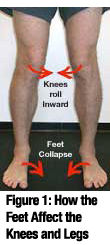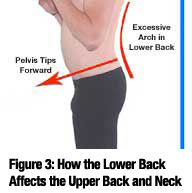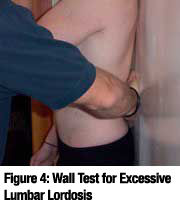
By JUSTIN PRICE, M.A.
It is standard practice for health and fitness professionals to use assessments to help clients reach their goals. Trainers who specialize in weight loss, for example, typically utilize body-fat ratios and/or calipers to establish baseline numbers and provide program feedback. Those who specialize in improving sports performance and/or fitness use other assessments such as VO2max testing and strength tests to help guide programs. And still others will utilize functional or movement screens to assess for musculoskeletal dysfunction. The purpose of all of these assessments is to use the results to design programs that increase a client’s activity level.
Look for the next article in the series in the February 2012 issue, detailing more static assessments you can use to identify musculoskeletal imbalances plus exercises to help correct them.
What traditional fitness assessments fail to take into consideration, however, is a person’s baseline musculoskeletal condition prior to any type of movement or exercise program. Traditionally, trainers have been taught to perform assessments related to specific training goals, implement exercise training programs, and keep their fingers crossed that the clients’ bodies hold up as their activity levels increase. Typically, when people get injured or develop chronic aches and pains, they give up their exercise programs and go through a period of rehabilitation with a licensed therapist. Since fitness professionals are trained specifically in muscle movement and function, shouldn’t the health and fitness industry as a whole have a structured approach for assessing clients’ baseline physical structure?
A New Age for Fitness Professionals
Until recently, the fitness industry has been content to place responsibility for tests that assess muscle and movement condition/dysfunction in the hands of physical therapists. Unfortunately, this strategy has benefited only the small fraction of the population that has access to this type of service. The reality is that a majority of musculoskeletal issues and chronic pain are a direct result of our modern, technology-focused, sedentary lifestyles. Consequently, the ability of most people to exercise regularly, let alone safely, has been severely compromised.
As a personal trainer, you are perfectly positioned, and well within your scope of practice, to help your clients minimize the impact of their musculoskeletal limitations. In fact, the fundamental concept of assessing a person’s musculoskeletal system prior to placing it under stress with movement and exercise is the driving force behind the ACE Integrated Fitness TrainingTM (ACE IFTTM) Model. The need for trainers to understand a client’s baseline musculoskeletal condition prior to exercise is paramount to any program, regardless of goals. As such, the ACE IFT Model protocols recommend specific structural and postural assessment procedures, adapted from The BioMechanics MethodTM of assessment and corrective exercise, as an important type of assessment to perform after gathering health-history information.
Posture Holds a Lifetime of Experience
Because these types of assessments have usually been left up to therapists or specialists, many trainers may feel intimidated by the prospect of assessing the musculoskeletal system. This may be due, in part, to the fact that the traditional notion of musculoskeletal assessment involves observing gait analysis or movements such as a squat or lunge. Complex motor skills like these require observation of many body parts, in motion, and are indeed very difficult to perform accurately. Assessing your client’s musculoskeletal system (i.e., posture) when he or she is not moving, however, is a much more manageable task. It can also tell you a great deal of information about the way the client moves.
To illustrate the usefulness of static structural assessments, consider a palm tree with a trunk that is bent over to one side. By looking at the tree on a still day, you can logically conclude that it leans in that direction because of prevailing winds that have shaped it to be that way. You don't need to see the tree in a windstorm to be able to infer what caused it to have a permanent bend. A similar principle applies to musculoskeletal assessment. Observation of a person’s static posture will help you understand where movement and environmental stressors have manifested in his or her body. You simply need to know where to look and what you are looking for (i.e., sitting sedentary for many hours a day may manifest in a person’s posture as rounded shoulders).
Static structural assessments can also enable you to make educated guesses regarding what will happen when a person begins to move or exercise. For example, if a client has rounded shoulders you can safely assume it will be difficult for him to raise his arms over his head correctly because his middle and upper back may not extend effectively enough to enable his shoulders to function well. Therefore, the information gleaned from static structural assessments can assist you in two ways. First, you will know what areas of a person’s musculoskeletal system need to be addressed with corrective exercises that you can integrate into his or her fitness program. Second, you will know where to watch for potential movement problems as your client progresses into an aesthetic, athletic or performance-based exercise program. Both of these benefits will help you minimize any potential for pain and/or injury.
What Does Posture Tell Us?

The results of an assessment of your client’s posture can tell you a great deal about his or her overall musculoskeletal condition. For example, if one were to establish the presence of excessive lumbar lordosis (i.e., an overly arched lower back), many trainers might assume that this condition is isolated to the lower back. However, because the body is a series of integrated parts, excessive lumbar lordosis can also be indicative of foot, ankle, knee, hip, pelvis, upper back, shoulder, head and/or neck alignment issues. Here’s why: When the feet overpronate (flatten out), the ankles roll inward over the foot. This inward rotation of the ankle, as depicted in Figure 1, causes the entire leg and knee to rotate inward toward the midline of the body (Kendall et. al, 2005).

This rotation of the leg moves the hip socket backward, which in turn rotates the pelvis down at the front and up at the back (i.e., an anterior tilt). This compensatory movement of the pelvis, depicted in Figure 2, causes the lower back to overarch (i.e., excessive lumbar lordosis).
If the lower back arches too much, then the middle and upper back must round forward (i.e., excessive thoracic kyphosis) to keep the body balanced. When the upper back rounds forward, the shoulder girdle moves away from the spine, causing the arms to internally rotate. Because the neck and head are attached to the upper part of the spine (i.e., thoracic spine), the head moves forward when the upper back rounds forward (Figure 3). For an individual to keep his or her eyes aligned with the horizon (or the television, computer screen, etc.) he or she must tilt the head back and up, causing the neck to overarch (Price and Bratcher, 2010).

Each piece of the body influences the pieces above and below. This means that if one part of the body is out of place, then it is likely that other parts are also out of alignment (Rolf, 1989). This is why static posture assessments are so valuable. Being able to assess where something is out of alignment can help you key in on specific imbalances, as well as other compensations in the body that, if left unaddressed, can make those areas prone to pain and injury. Furthermore, static structural assessments can help you establish which part(s) of a person’s body are likely to cause problems when he or she moves and enable you to address those imbalances accordingly in your exercise program design.
Static Structural Assessment Example

The Wall Test is a simple static assessment for evaluating excessive lumbar lordosis. Ask the client to stand with his or her back against a wall with the heels, buttocks, shoulders and head all in contact with the wall. Place your hand, palm down, on the wall and slide it behind the client’s lower back (Figure 4).
Evaluate the space between the lumbar spine and the wall. When a person has an acceptable degree of lumbar lordosis, you should only be able to slide your fingers behind the lower back up to, and in line with, the second or third knuckle of your hand (i.e., where the fingers meet the hand). If the space between the person’s back and the wall is big enough for you to slide your whole hand or arm through, then the client has excessive lumbar lordosis. The greater the space between the wall and the client’s lower back, the more extreme the deviation or imbalance.
Note: You will need to make an allowance for additional space if someone has a large gluteal complex and his or her tailbone is not in contact with the wall during the assessment. Use your best judgment to determine whether the lumbar curvature is excessive.
Use a Structured Approach
By now it should be apparent why the use of static posture assessments is such a vital aspect of designing safe, effective and challenging exercise programs. Incorporating a series of insightful static assessments into your intake protocols will enable you to help clients avoid exercise-related injuries and harmful musculoskeletal stress.
References
Kendall, F.P. et al. (2005). Muscle Testing and Function with Posture and Pain (5th ed.). Baltimore, Md.: Lippincott Williams & Wilkins.
Price, J. and Bratcher, M. (2010). The BioMechanics Method (Level One).
Rolf, I.P. (1989). Rolfing: Reestablishing the Natural Alignment and Structural Integration of the Human Body for Vitality and Well-Being (revised edition). Rochester, Vt.: Healing Arts Press.
_______________________________________________________________________________

Justin Price, M.A., is a subject-matter expert for the American Council on Exercise on structural assessment and corrective exercise, and the creator of The BioMechanics Method, which provides corrective exercise education for health and fitness professionals. He is also an IDEA Personal Trainer of the Year and an education provider for PTontheNet, PTA Global and the National Strength and Conditioning Association.